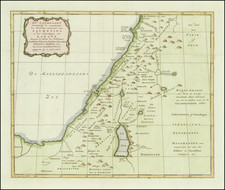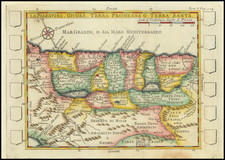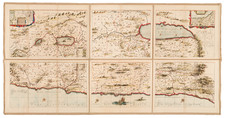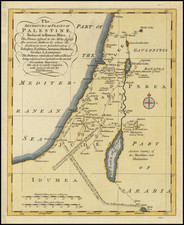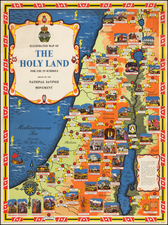The First Printed View of Jerusalem
A spectacular, full original hand-color example of the most desirable of all views of Jerusalem and the Holy Land, the 1486 first edition of Erhard Reuwich's famed woodcut.
The view is oriented with east at the top, following the traditions of Medieval Mappa Mundi, which were so-arranged to privilege Jerusalem's place in the world. At the far left (north) of the view is the city of Tripoli, Lebanon. Dozens of towns and landforms are shown in the northern section of the map, accompanied by numerous Latin annotations.
The central sheet of the view is dominated by an oversized bird's-eye view of Jerusalem, with a centrally located Dome of the Rock, erroneously labeled "Templu Salohois" (the Temple of Solomon). Jerusalem was the goal of Breydenbach's pilgrimage, and so it receives the most impressive treatment of all of the book's famous views (though Venice is a looker as well). The view of Jerusalem is taken from the east, as if the viewer were on the Mount of Olives (rather than perched over the Mediterranean), allowing Breydenbach's readers to visualize the city as Christ saw the Holy City in Luke 19:41-44. Despite this sleight of hand, the view was the most architecturally accurate of any done up to that point (that includes Medieval manuscript renditions).
The right side of the view features Mount Sanai, Cairo, Alexandria, and the Red Sea (aptly colored red in this example).
Breydenbach's foremost bibliographer Hugh Davies wrote that the 1486 views “are distinguished from other woodcut views published in the fifteenth century by their air of truth as well as their liveliness, being full of groups of figures, some pursuing their everyday occupations."
The view was included in the 1486 first edition of Bernhard von Breydenbach's Peregrinatio in terram sanctam, a guide to European pilgrims to the Holy Land and one, if not the earliest, printed travel book.
Hand-Coloring and Rarity
The original hand-coloring of the view is characteristic of late-15th-century German colorists, inviting comparison with the Weltchronik-Meister responsible for the coloring of Schedel's Nuremberg Chronicle.
It is difficult to determine the dating of examples of the view that have traded in the past (we suspect that many recorded as 1486 woodblock are in fact from the 1502 edition or later). But our research suggests that no examples of the 1486 woodblock have traded in the last decade and that no copies recorded in OldMaps.com were in original hand color.
Bernhard von Breydenbach (1440-1497), Dean of Mainz, authored a preeminent narrative of his pilgrimage to the Holy Land, which was the first to be printed with views of the places visited en route. Breydenbach demonstrated considerable foresight by employing a talented artist to create accurate and captivating illustrations of the locations from Venice to Mount Sinai. These illustrations greatly contributed to the book's popularity and interest. Initially published in Latin, the book was soon translated into German and Flemish, likely under the Dean's direction. Subsequent editions and translations into other languages were published independently over a 36-year period.
Born into the noble line of Breidenbach-Büresheim, Breydenbach was the son of Gerlach von Breidenbach. In 1450, he became a Canon of Mainz, proving his nobility to the Chapter on October 4. He also held positions as a member of the Ritterstift of St. Alban and the Collegiatstift of Our Lady. Furthermore, he served as a Doctor of Laws, Protonotary to the Apostolic Chair, Chamberlain to the Courts of Justice (1477-1493), and from 1484, the Dean of the Cathedral. Although he was a Canon, it seems that he was not ordained as a priest even by 1483.
Breydenbach's pilgrimage took place from April 25, 1483, to the end of January 1484. On October 1, 1484, he was commissioned by the Pope to transmit the pallium from Rome to the newly-elected Archbishop of Mainz. In the relevant document, he is referred to as the Dean. In 1486, Breydenbach accompanied the Archbishop, to whom the Itinerarium is dedicated, to Aachen for the coronation of Emperor Maximilian I on April 9th. The Archbishops of Mainz traditionally had the right to crown the German Emperors.











![[Cyprus, Holy Land & Medina]](https://storage.googleapis.com/raremaps/img/small/87154.jpg)
